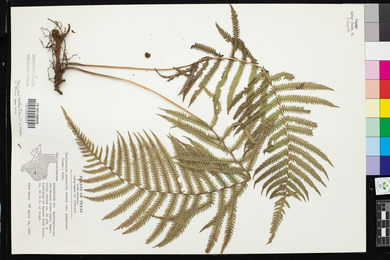Thelypteris palustris var. pubescens
|
|
|
|
Family: Thelypteridaceae
Eastern Marsh Fern
[Dryopteris tremula] |
Stems long-creeping, 1--3 mm diam. Leaves monomorphic or slightly dimorphic, dying back in winter, often 1--3 cm apart, fertile leaves more erect, narrower, and with somewhat contracted pinnae and segments, 20--90 cm. Petiole straw-colored above base, 9--45(--60) cm × 1--3 mm, at base sparsely set with tan, ovate, glabrous scales. Blade lanceolate, 10--40(--55) cm, proximal pinnae commonly slightly shorter, blade tapering gradually to pinnatifid apex. Pinnae pinnatifid to within 1 mm of costa, 2--10 × 0.5--2 cm; segments oblong, somewhat oblique, entire; proximal pair of veins from adjacent segments meeting margin above sinus, veins frequently forked. Indument abaxially of sparsely to densely set hairs on costae and sometimes veins, costae also commonly with a few small, tan scales, blade tissue glabrous on both sides. Sori round, medial; indusia tan, often hairy; sporangia glabrous. 2 n = 70. Terrestrial in swamps, bogs, and marshes, also along riverbanks and roadside ditches, and in wet woods; 0--1000 m; St. Pierre and Miquelon; Man., N.B., Nfld., N.S., Ont., P.E.I., Que.; Ala., Ark., Conn., Del., D.C., Fla., Ga., Ill., Ind., Iowa, Kans., Ky., La., Maine, Md., Mass., Mich., Minn., Miss., Mo., Nebr., N.H., N.J., N.Y., N.C., N.Dak., Ohio, Okla., Pa., R.I., S.C., S.Dak., Tenn., Tex., Vt., Va., W.Va., Wis.; perhaps Mexico (as Dryopteris tremula H. Christ); West Indies in Bermuda, Cuba. Perennial fern 20 - 90 cm tall Leaves: all of fairly similar shape (fertile leaves a bit different), green, 10 - 55 cm long, up to 20 cm wide, lance-shaped in outline, but pinnately compound with deeply pinnately lobed leaf divisions (pinnae), and gradually tapered, pinnately-lobed tip. The fertile leaves are more erect, narrower, and usually have more narrow pinnae and lobes. All leaves die back in winter. Rhizome: long-creeping, 1 - 3 mm in diameter, and scaly at apex. Leaf stalks: spaced 1 - 3 cm apart, straw-colored, but darker (almost black) at base, 9 - 55 cm long, 1 - 3 mm wide, and sparsely covered with tan, egg-shaped scales below. Spores: numerous, all of one kind, and single-sectioned (monolete). The spores are released from August to October, and give rise to the gametophyte (the sexual phase of the plant), which is small, green, heart-shaped, usually hairy or glandular, and sits above the ground. Similar species: In the Chicago Region, Thelypteris palustris var. pubescens is most similar to T. noveboracensis, but in that species the lowest pairs of leaf divisions (pinnae) are significantly shorter than the ones in the middle of the leaf, the pinnae "midribs" (costae) do not have scales on their underside, the upper surface of the pinnae often have hairs along the veins, and the underside of the blade tissue sometimes has some yellowish to light orange, stalkless glands. The typical variety of T. palustris only occurs in Europe and Asia. Also similar are our two species of Phegopteris, P. connectilis and P. hexagonoptera, but both of those species have leaf blades with at least the uppermost leaf divisions (pinnae) not fully divided to the "midrib" (rachis) with connecting tissue between the pinnae, and the "midribs" of the pinnae (costae) are not grooved on the upper side. Members of the Dryopteridaceae family (genera such as Dryopteris, Cystopteris, Woodsia, Athyrium, and Deparia) may be confused with this species, but members of that family lack needle-like hairs, often possess scales on the leaf blades (not just the costae), and the leaf blades are typically compoundly divided much more than once. Habitat and ecology: Common, often very abundant in particular wet habitats such as bogs, marshy ground, calcareous fens, and shallow pond margins. Occurence in the Chicago region: native Notes: In a very wide sense, the genus Thelypteris is an incredibly large and complex genus of approximately 900 species, and it would be the only genus in the Thelypteridaceae family. Some have divided the genus into about thirty other genera, which are treated as subgenera or sections by various taxonomists. We follow the Flora of North America (1993), which separates only two other distinct groups as separate genera: Phegopteris and Macrothelypteris. Thelypteris palustris var. pubescens is in the subgenus Thelypteris, which can be distinguished from the other subgenera of Thelypteris by having leaves that die in winter, long-creeping rhizomes (1 - 3 mm diameter), singly pinnate leaves that are further deeply pinnately lobed (pinnate-pinnatifid), lower leaf divisions (pinnae) that are about the same length as those in the middle of the blade, veins that often fork and join the leaf blade edge above the lowest point of the pinnae lobes, and scales along the underside of the pinnae "midribs" (costae). Author: The Field Museum From Flora of Indiana (1940) by Charles C. Deam Common in the lake area and infrequent south of it. In the lake area it is common in tamarack bogs, sedge marshes, and on the low borders of lakes. South of this place it is found in springy and marshy areas. …… Indiana Coefficient of Conservatism: C = 7 Wetland Indicator Status: OBL |

















































































